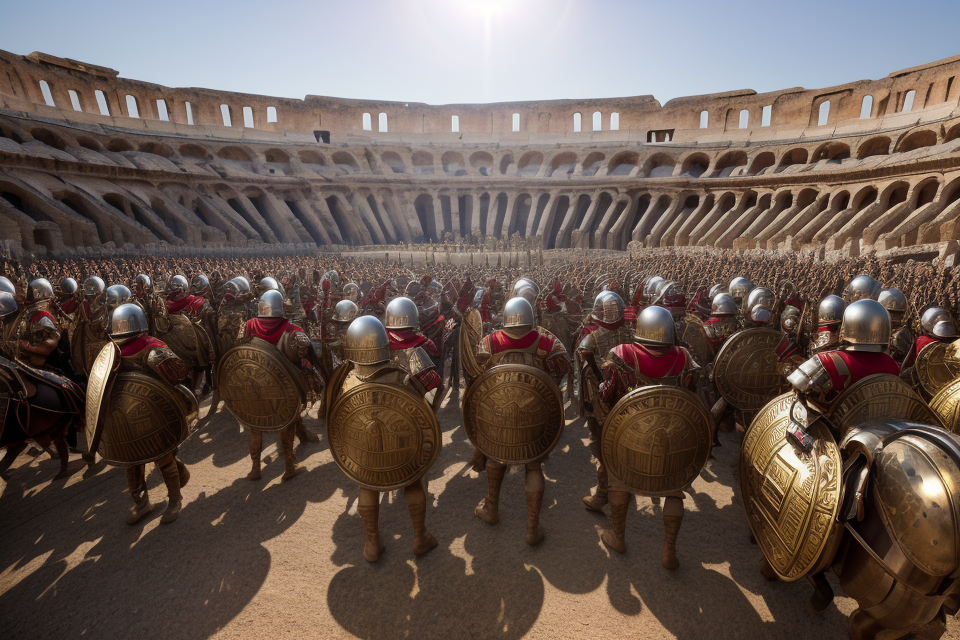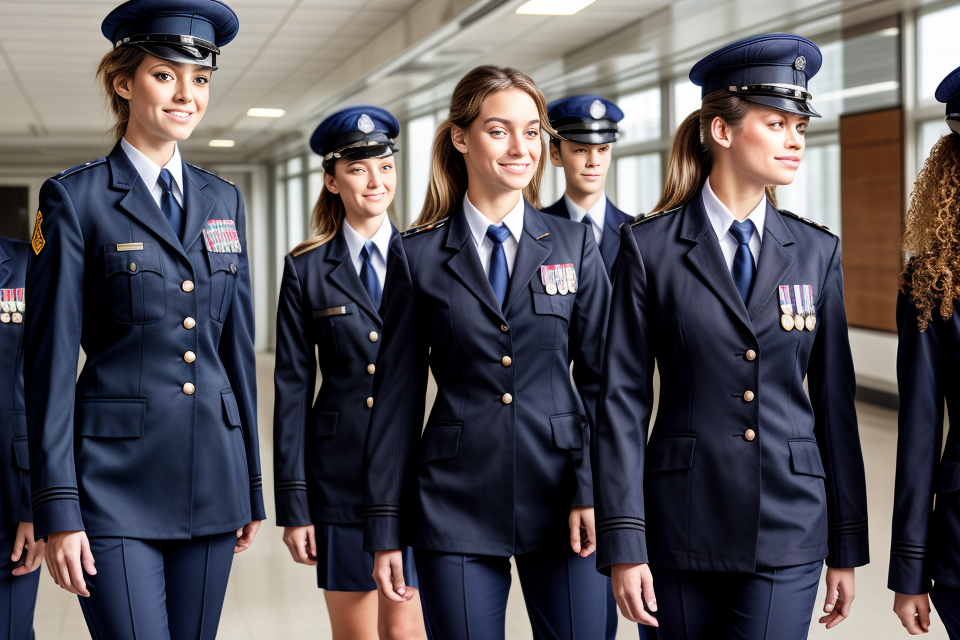
Uniforms have been a part of human society for centuries, but have you ever wondered why people started wearing them in the first place? The concept of uniforms dates back to ancient times, where they were used to identify soldiers, servants, and even slaves. But as time passed, the purpose of uniforms evolved, and they became a symbol of unity, identity, and professionalism. In this article, we will delve into the history and purpose of uniforms, and explore why they have become an integral part of our daily lives. From the military to the workplace, uniforms have played a crucial role in shaping our society, and this article will take you on a journey through time to uncover their fascinating story.
The Origins of Uniforms
Military uniforms
Early use of uniforms in warfare
Uniforms have been used in warfare for centuries, with the earliest recorded use dating back to ancient Rome. The Roman legions were among the first to adopt a standardized form of dress, which included a distinctive helmet, breastplate, and cloak. This uniform was designed to promote a sense of unity and identity among the soldiers, as well as to distinguish them from their enemies.
Distinguishing between friends and foes
The use of uniforms in warfare has been primarily focused on distinguishing between friends and foes. This has been especially important in situations where the two sides are similarly dressed or where the battlefield is unclear. The use of uniforms has allowed soldiers to identify their comrades and to differentiate them from the enemy. This has been particularly important in situations where soldiers are fighting in close quarters, such as in hand-to-hand combat or in trench warfare.
Developing a sense of unity and discipline
Uniforms have also been used to promote a sense of unity and discipline among soldiers. By wearing a uniform, soldiers are able to identify with a larger group and to feel a sense of belonging. This can be especially important in situations where soldiers are fighting far from home or where they are separated from their families for extended periods of time. In addition, the use of uniforms can help to promote discipline and order, as soldiers are expected to adhere to a set of rules and regulations that govern their appearance and behavior.
Religious uniforms
Uniforms have been a part of religious traditions for centuries, with various religions using distinctive clothing to symbolize devotion and commitment to their faith. The use of religious uniforms dates back to ancient times, with priests and monks wearing distinctive robes to identify themselves as members of a particular religious order.
One of the earliest examples of religious uniforms can be traced back to ancient Egypt, where priests wore elaborate headdresses and long robes as a symbol of their religious authority. Similarly, in ancient Greece, priests of the oracle at Delphi wore distinctive garments that identified them as religious officials.
In Christianity, the use of religious uniforms dates back to the early centuries of the religion. The clergy of the early Christian church wore distinctive clothing to identify themselves as members of the religious order. By the medieval period, the use of religious uniforms had become widespread, with monks and nuns wearing distinctive robes and habits that identified them as members of their respective orders.
The use of religious uniforms was not limited to Christianity, as other religions also adopted the use of distinctive clothing. For example, in Hinduism, priests and ascetics often wear saffron-colored robes as a symbol of their spiritual devotion. Similarly, in Buddhism, monks and nuns wear distinctive robes that identify them as members of their respective orders.
The use of religious uniforms served several purposes beyond identifying members of a particular religious order. For example, the use of distinctive clothing helped to establish a sense of community and identity among members of a religious group. Additionally, the use of religious uniforms helped to reinforce the idea of religious authority and hierarchy within a particular religious tradition.
In modern times, the use of religious uniforms has continued, with various religious traditions requiring their members to wear distinctive clothing as a symbol of their faith. However, the specific nature of religious uniforms can vary widely depending on the particular religion and cultural context.
Work uniforms
Early examples of uniforms in professions such as law enforcement and firefighting were introduced in the late 19th century. The adoption of uniforms in these professions was primarily driven by the need to enhance identification and accountability. By wearing a distinctive uniform, individuals in these professions could be easily identified by the public, which helped to improve accountability and trust.
The use of uniforms in law enforcement, for example, helped to establish a sense of authority and professionalism. Prior to the introduction of uniforms, law enforcement officers often wore regular clothing, which made it difficult for the public to identify them as officials. The introduction of uniforms with distinctive badges and insignia helped to establish a clear visual identity for law enforcement officers, which enhanced their authority and credibility.
Similarly, the use of uniforms in firefighting helped to establish a professional image and enhance identification and accountability. Prior to the introduction of uniforms, firefighters often wore regular clothing, which made it difficult for the public to identify them as firefighters. The introduction of distinctive uniforms with insignia helped to establish a clear visual identity for firefighters, which enhanced their authority and credibility.
Overall, the use of uniforms in work settings has played a crucial role in enhancing identification and accountability, as well as projecting a professional image. By wearing a distinctive uniform, individuals in various professions have been able to establish a clear visual identity, which has helped to enhance their authority and credibility.
The Purpose of Uniforms
Safety and identification
Uniforms have been a staple in many industries and organizations for centuries, and their primary purpose has always been centered around safety and identification. The following are some of the reasons why uniforms are designed to promote safety and identification.
- Easier to identify individuals in hazardous situations
One of the most significant advantages of wearing uniforms is that they make it easier to identify individuals in hazardous situations. For instance, in the military, police officers, firefighters, and paramedics all wear uniforms that are designed to make them easily identifiable in emergency situations. This helps to ensure that first responders can quickly identify who is in charge and who they should be working with to mitigate the situation.
Additionally, in industries such as construction and manufacturing, wearing uniforms can help to prevent accidents by making it easier to identify workers who are authorized to be on a particular job site. This can help to prevent unauthorized access to dangerous areas and reduce the risk of accidents.
- Enhancing safety standards by ensuring compliance with specific clothing and equipment requirements
Uniforms also help to enhance safety standards by ensuring compliance with specific clothing and equipment requirements. For example, many workplaces require employees to wear protective gear such as hard hats, safety glasses, and reflective vests. These items are designed to protect workers from injuries that could occur on the job, and wearing them is often mandatory.
By wearing uniforms, employers can ensure that their employees are adhering to these safety standards, which can help to reduce the risk of accidents and injuries. Furthermore, uniforms can help to promote a culture of safety by making it clear that safety is a top priority in the workplace.
In conclusion, the purpose of uniforms is multifaceted, but their primary purpose has always been centered around safety and identification. By wearing uniforms, individuals can be easily identified in hazardous situations, and employers can ensure that their employees are adhering to specific safety standards.
Building a sense of community
One of the primary purposes of wearing uniforms is to foster a sense of community among individuals who wear them. This can include promoting a sense of belonging and unity, encouraging a shared identity and values, and facilitating teamwork and cooperation.
- Promoting a sense of belonging and unity: Wearing a uniform can help individuals feel like they are part of a larger group or organization. This can be particularly important for individuals who may feel isolated or disconnected from their surroundings, such as military personnel or students in a school setting. By wearing a uniform, these individuals can feel a sense of belonging and connection to their fellow members.
- Encouraging a shared identity and values: Uniforms can also help promote a shared identity and values among individuals who wear them. This can be particularly important in settings where individuals come from diverse backgrounds or have different beliefs and perspectives. By wearing a uniform, individuals can demonstrate their commitment to a shared set of values and goals, which can help foster a sense of unity and common purpose.
- Facilitating teamwork and cooperation: Uniforms can also help facilitate teamwork and cooperation among individuals who wear them. This can be particularly important in settings where individuals must work together to achieve a common goal, such as in a sports team or a military unit. By wearing a uniform, individuals can demonstrate their commitment to the team and their willingness to work together towards a common goal. This can help foster a sense of cooperation and teamwork among individuals, which can be critical to achieving success in these settings.
Presenting a professional image
Uniforms have been a staple in many industries and organizations for centuries, serving as a way to present a professional image. One of the primary purposes of uniforms is to create a consistent and recognizable look for a particular group or organization. This can help to establish a sense of unity and belonging among members, as well as create a clear visual distinction between members and non-members.
In addition to creating a uniform look, uniforms also serve to demonstrate professionalism and competence. When individuals wear a uniform, they are making a statement about their commitment to their role and their organization. This can help to establish trust and credibility with customers, clients, and other stakeholders.
Another benefit of wearing uniforms is that they can help to reduce the need for individuals to make decisions about their attire on a daily basis. By providing a set of guidelines for what is appropriate to wear, uniforms can simplify the dressing process and help individuals to focus on their work rather than their appearance.
Overall, the purpose of uniforms in presenting a professional image is to create a consistent and recognizable look, demonstrate professionalism and competence, and simplify the dressing process.
The Evolution of Uniforms
Changing styles and designs
Throughout history, uniforms have undergone significant changes in their styles and designs. These changes have been influenced by various factors, including the impact of fashion, the adaptation of new materials and technologies, and the incorporation of cultural and regional influences.
The impact of fashion on uniform design
Fashion has played a significant role in shaping the design of uniforms. As fashion trends have evolved over time, so too have the styles and designs of uniforms. For example, in the past, military uniforms were often designed to reflect the latest fashion trends of the time. Similarly, the styles of police uniforms have changed over time to reflect the changing fashion trends of society.
Adapting to new materials and technologies
Another factor that has influenced the changing styles and designs of uniforms is the adaptation of new materials and technologies. As new materials have become available, they have been incorporated into the design of uniforms to improve their functionality and durability. For example, the use of synthetic fabrics in the design of police uniforms has allowed for greater flexibility and movement, while the use of moisture-wicking materials in the design of sports uniforms has improved comfort and performance.
Incorporating cultural and regional influences
Uniforms have also been influenced by cultural and regional influences. For example, traditional dress worn by certain cultures or regions may have been incorporated into the design of uniforms. Additionally, uniforms may have been designed to reflect the history or culture of a particular organization or institution.
Overall, the changing styles and designs of uniforms reflect the evolving needs and preferences of society, as well as advances in materials and technology.
Functionality and practicality
From the earliest beginnings of uniforms, the primary goal has been to balance style with practicality. The uniforms were designed to address the needs of diverse professions and environments while ensuring comfort and mobility.
Balancing style with practicality
The first uniforms were often simple and practical, designed to protect the wearer from the elements and identify them as part of a particular group. Over time, as the purpose of uniforms expanded, so did their design. The balance between style and practicality became more complex, with different uniforms being designed for different purposes.
Addressing the needs of diverse professions and environments
Uniforms have been designed for a wide range of professions, from military personnel to police officers, firefighters, and healthcare workers. Each profession has its own unique set of requirements, and the uniforms are designed to meet those needs. For example, a police officer’s uniform needs to be functional for the purposes of carrying equipment and providing identification, while a nurse’s uniform needs to be comfortable and allow for easy movement.
Ensuring comfort and mobility
Comfort and mobility are also important considerations in the design of uniforms. Uniforms that are ill-fitting or uncomfortable can negatively impact the wearer’s ability to perform their job effectively. Additionally, uniforms that restrict movement can make it difficult for the wearer to perform physically demanding tasks. As a result, uniform designers must balance style with practicality to ensure that the uniform is both functional and comfortable.
FAQs
1. Why did people start wearing uniforms?
People started wearing uniforms for various reasons throughout history. One of the earliest reasons was for identification purposes, so that soldiers on the battlefield could distinguish friend from foe. Uniforms also helped to establish a sense of unity and belonging among members of an organization, such as the military, police, or fire department. In addition, uniforms were often used to convey social status or occupation, such as the clothing worn by priests, nuns, or nobility.
2. What is the history of uniforms?
The history of uniforms dates back to ancient times, where soldiers and other individuals were often dressed in distinctive clothing to signify their occupation or social status. In Europe during the Middle Ages, knights and nobility wore elaborate clothing to display their wealth and power. In the modern era, uniforms have become a standard part of many organizations, including the military, police, fire department, and various public service and private sector industries.
3. What are the benefits of wearing uniforms?
There are several benefits to wearing uniforms. One of the main benefits is that it helps to establish a sense of identity and belonging among members of an organization. Uniforms also help to promote a professional image and convey a sense of authority, which can be important for organizations such as the police or military. In addition, uniforms can help to improve safety by making it easier to identify individuals who are authorized to be in certain areas or to perform certain tasks. Finally, uniforms can help to reduce social and economic disparities by providing a consistent and professional appearance, regardless of an individual’s personal background or socioeconomic status.
4. What are some common types of uniforms?
There are many different types of uniforms, each designed for a specific purpose or occupation. Some common types of uniforms include military uniforms, police uniforms, fire department uniforms, medical uniforms, and school uniforms. In addition, many private sector industries, such as retail, hospitality, and transportation, require their employees to wear uniforms as part of their job. Uniforms can vary widely in design and materials, depending on the specific requirements of the organization and the occupation of the individual wearing the uniform.
5. Can people choose what they wear as part of a uniform?
In some cases, individuals may have the opportunity to choose their own uniforms, either by selecting from a pre-approved list of options or by designing their own uniforms within certain guidelines. However, in many cases, uniforms are standardized and must be worn as issued by the organization. This is particularly true for organizations such as the military, police, and fire department, where uniforms are designed to meet specific functional and safety requirements. In addition, some organizations may have dress codes or other guidelines that must be followed when wearing the uniform, even if the individual has some choice in the specific clothing items worn.

